
How to Optimize Table Category View for Magento 2?
Wondering what is a simpler way to browse products on Magento 2? The Table Category View for Magento 2 simplifies product navigation. It helps in navigation and makes browsing and selecting products easier for customers.
This tutorial will explore the steps to set up products using the extension and cover how to improve the user experience.
Key Takeaways
- Discover how the Table Category View extension enhances product display in Magento 2.
- Learn how to organize configurable products using the table view feature efficiently.
- Understand how the table view simplifies navigation and improves the user experience.
- Learn how to keep track of products with ease as they are added to the product list.
- Understand the potential to allow customers to navigate seamlessly through product categories.
-
Importance of Table Category View for Magento E-Commerce Stores
-
7 Common Issues in Implementing Table Category View in Magento 2
-
Future Trends and Developments of Magento Table Category View
What is Table Category View for Magento 2?
Table Category View for Magento 2 is a display format for the category page. It offers a structured grid layout for products.
Table category view provides a convenient way to showcase configurable Magento products. It lets customers add many items to their cart from the category page. The table category view simplifies shopping. It reduces the time customers spend browsing and adding items to their carts.
Importance of Table Category View for Magento E-Commerce Stores
1. Enhanced Shopping Experience
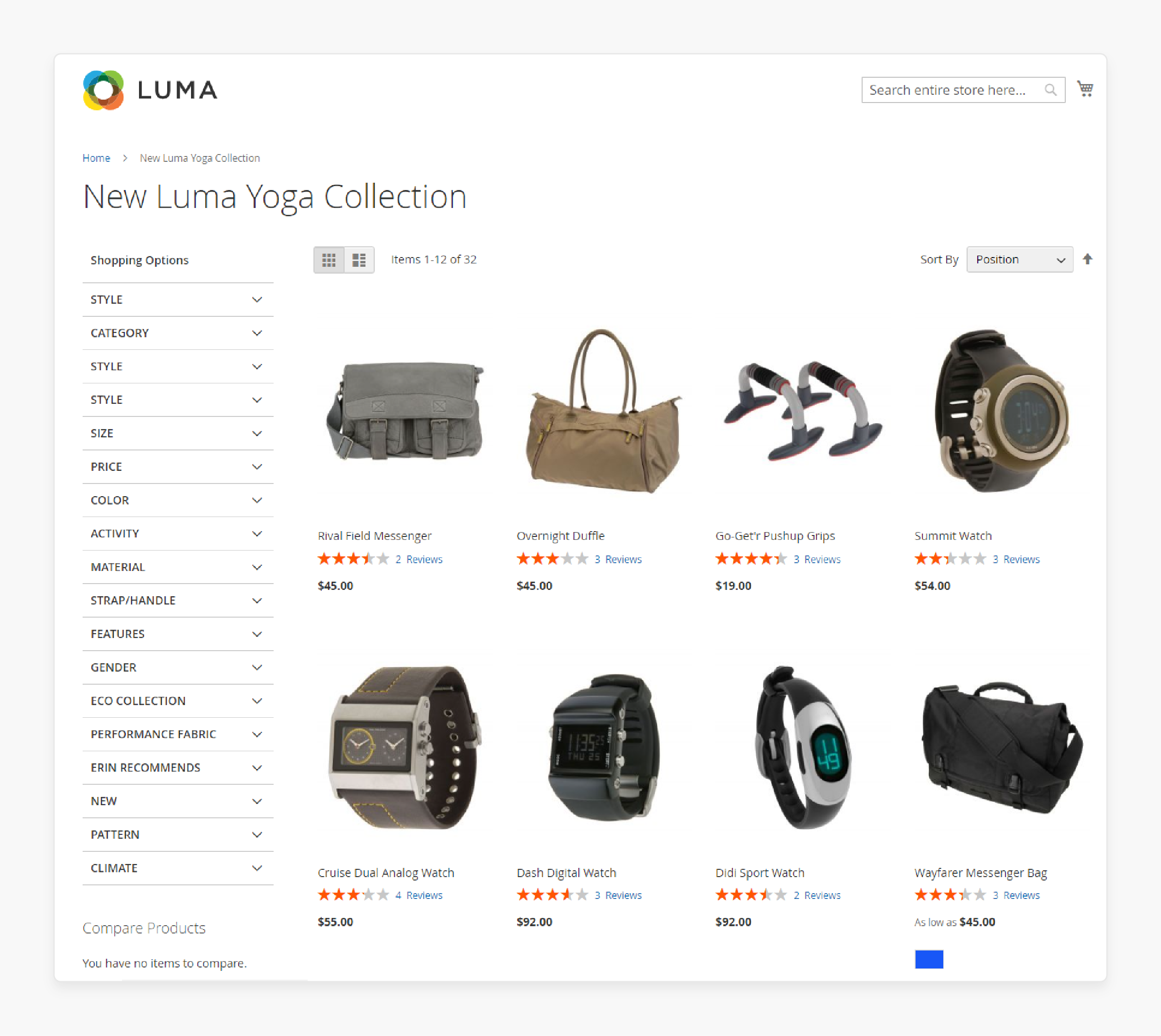
The Table Category View is important for Magento e-commerce. It offers a user-friendly format for showing products to the cart on category pages. Having detailed tables significantly reduces shopping time. The features of magento 2 enhance the overall shopping experience on the site.
2. Efficient Product Exploration
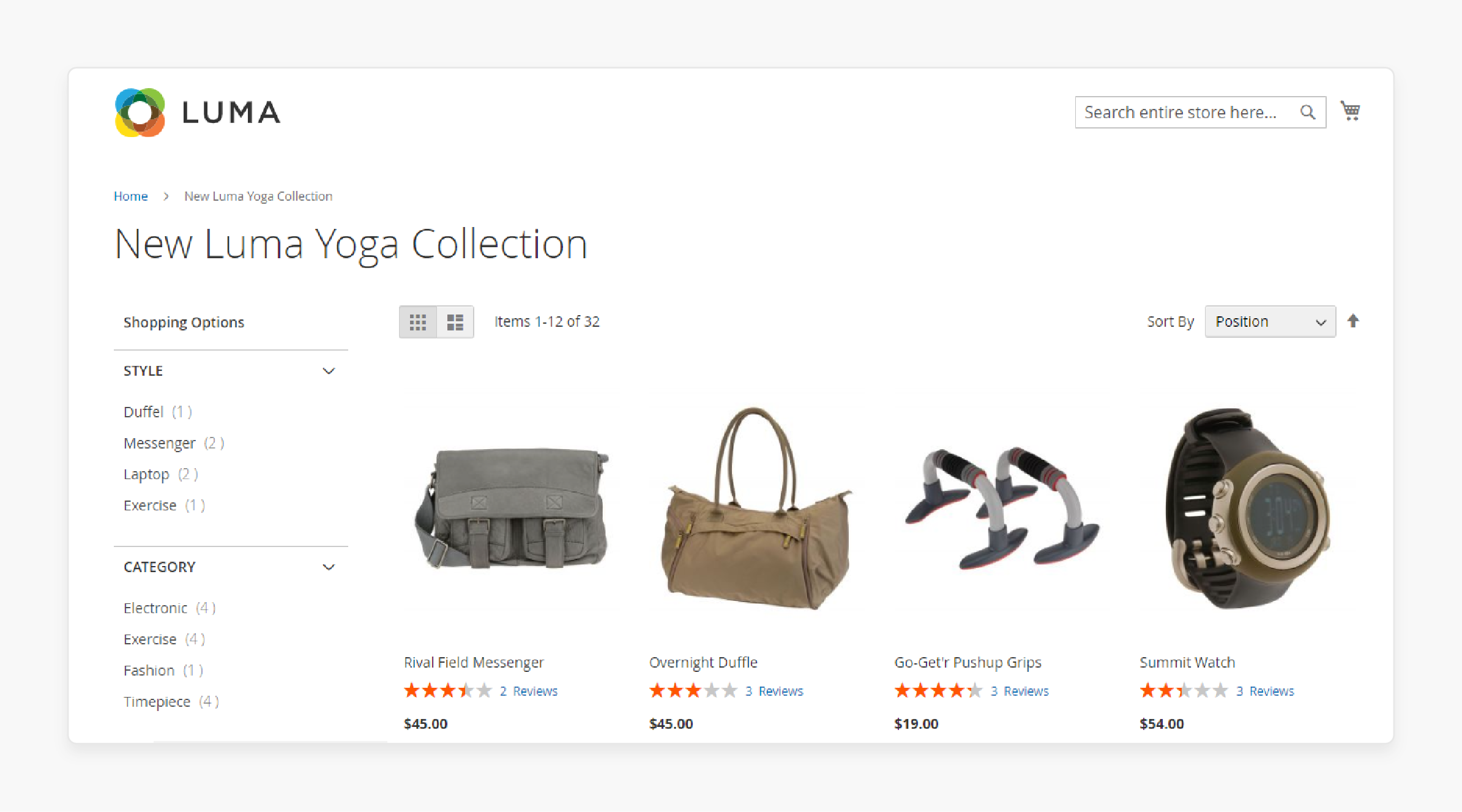
With features like grid view and matrix view, the Table Category View allows customers to explore product categories in a structured and organized layout efficiently. It streamlines the shopping process, enhancing the overall experience on the site and reducing the need to navigate to individual product pages.
3. Streamlined Purchasing Process
Customers can easily add products to their cart with just a few clicks, thanks to the intuitive interface of the Table Category View. It streamlines the purchasing process and encourages higher conversion rates. Customers can swiftly complete purchases with the Table Category View. Understanding product details and adding multiple items at once leads to improved conversion rates.
4. Product Comparison and Customization
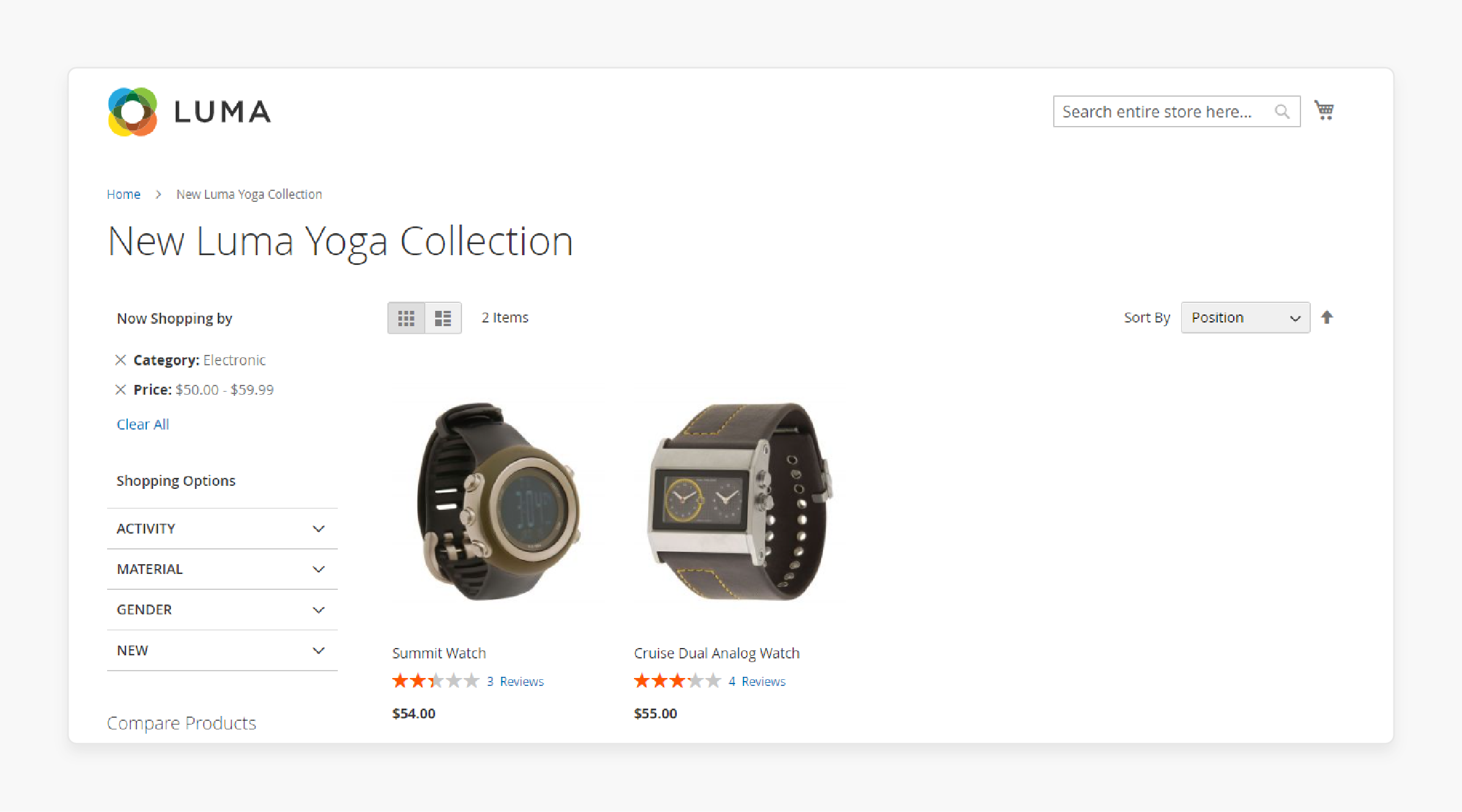
The Table Category View enables customers to compare products within a category and customize quantities according to their preferences. The functionality enhances the convenience and flexibility of the shopping experience. It is coupled with the ability to customize quantities directly from the detailed table.
5. Improved Interface and Engagement
By offering a more engaging and convenient interface, the Table Category View contributes to increased user engagement and satisfaction. It ultimately leads to higher customer retention and loyalty for Magento 2 e-commerce stores.
8 Key Features of Table Category View for Magento 2
1. Structured Product Display
- A structured table format organizes products into categories. They are arranged in columns and rows, like a spreadsheet.
- For instance, in an electronics store's Laptops category, each row is a different laptop model. Columns display attributes such as brand, processor type, and price.
- Products belonging to a category are grouped together based on similar characteristics or product attributes.
- The structured presentation enables customers to add multiple products. It helps them make informed purchasing decisions quickly.
2. Sortable Columns
- In the table category view, customers can sort products by different attributes.
- These attributes include price, name, and relevance.
- For example, in the Smartphones category, customers can sort products by price. This helps them find the cheapest options.
- The sortable column empowers customers to personalize their browsing.
3. Filtering Options
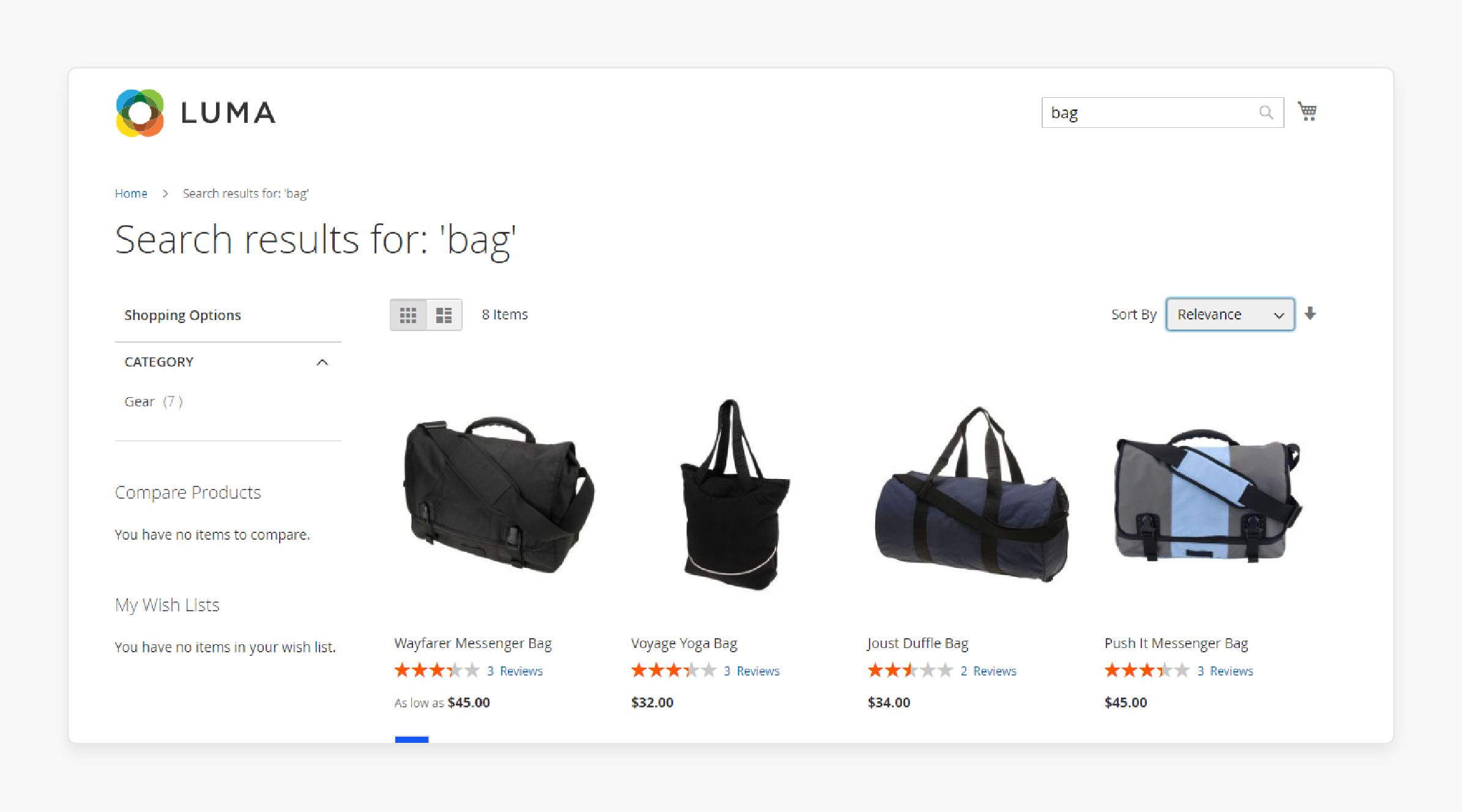
- In Magento, the table category view, users can refine Magento product page searches. It can be done using filters.
- The filters are based on attributes like price range, brand, or product features.
- For example, in the Shoe category, customers can filter products. They do this by selecting price ranges, brands, or shoe sizes.
- The feature makes the product discovery process faster. It helps users narrow down options.
4. Pagination
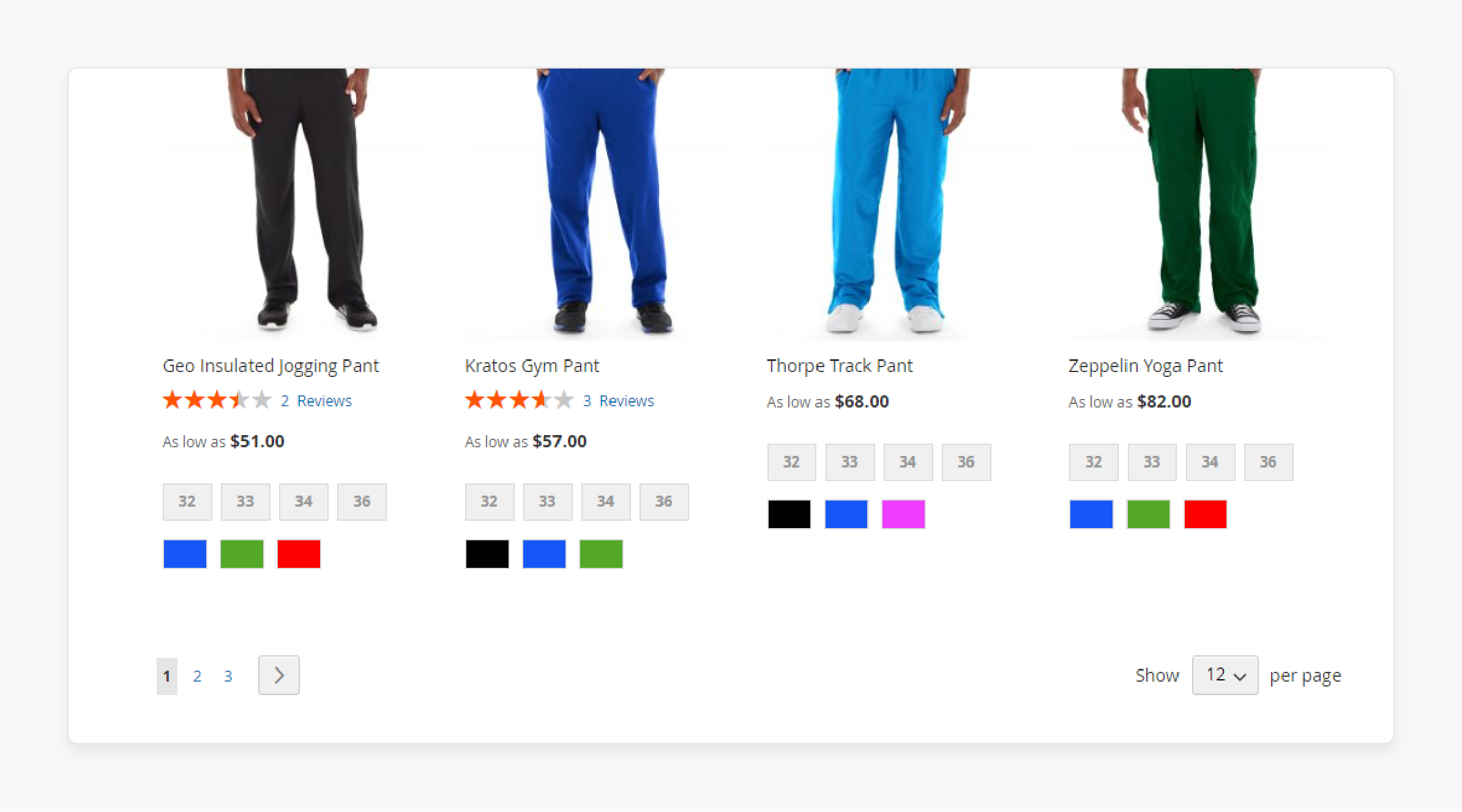
- The table category view has pagination for large product catalogs.
- Customers can stay on the category page to explore a wide range of products before making a selection.
- For instance, consider a Books category with many titles. Pagination lets users move between pages. It can be used to explore more listings beyond the first page.
- The feature ensures that customers can easily access the entire Magento catalog. It enhances their shopping experience and enables efficient product list-added page discovery.
5. Responsive Design
- In Magento, responsiveness is a key feature of the product on the category page. It ensures the display and functionality work well on many devices and screen sizes.
- For example, you can access it on a desktop, tablet, or smartphone. The table category will be applied to showcase product listings effectively.
- Elevate your customer experience with intuitive navigation and user-friendly design.
- It also lets users interact with them. It lets customers browse and shop easily on any device.
6. Customization
- Merchants using the Magento 2 default store can customize the content and design table in the category view.
- It can change the look and functionality using the admin panel or extensions.
- For instance, it can adjust the layout and columns. The customization can add features like advanced filters.
- Child products are variants of a parent product in Magento, allowing for greater customization.
- Customize the category page layout to optimize product presentation and navigation.
- It empowers merchants to create a tailored browsing experience. It reflects their brand and enhances user engagement.
7. Integration with Attributes and Attributes Sets
- In the Magento 2 table category view extension, the products are linked to attributes. It makes for flexible product management and organization.
- For instance, a Clothing category might include attributes like size, color, and material. It can let merchants categorize products well.
- The feature lets merchants arrange their product catalog to fit their needs.
- Use dropdown menus to select options or navigate through categories effortlessly.
- It makes management easier and improves the Magento browsing experience for customers.
8. SEO-Friendly
- In Magento, the table category view module is made for search engines.
- It has clean URLs, meta tags, and other SEO-friendly elements. These boost visibility and ranking.
- For example, category URLs are logical and keyword-rich. Meta tags are customizable, boosting click-through rates.
- The features make product listings easy for search engines to find.
- It brings more organic traffic to the online store.
10 Steps to Configure Magento 2 Table Category View
Step 1: Log in to the Magento Admin Panel
- Enter your Magento 2 admin panel using your username and password.
Step 2: Navigate to Configuration
- Click on Stores in the main menu, then select Configuration.
Step 3: Access Catalog Settings
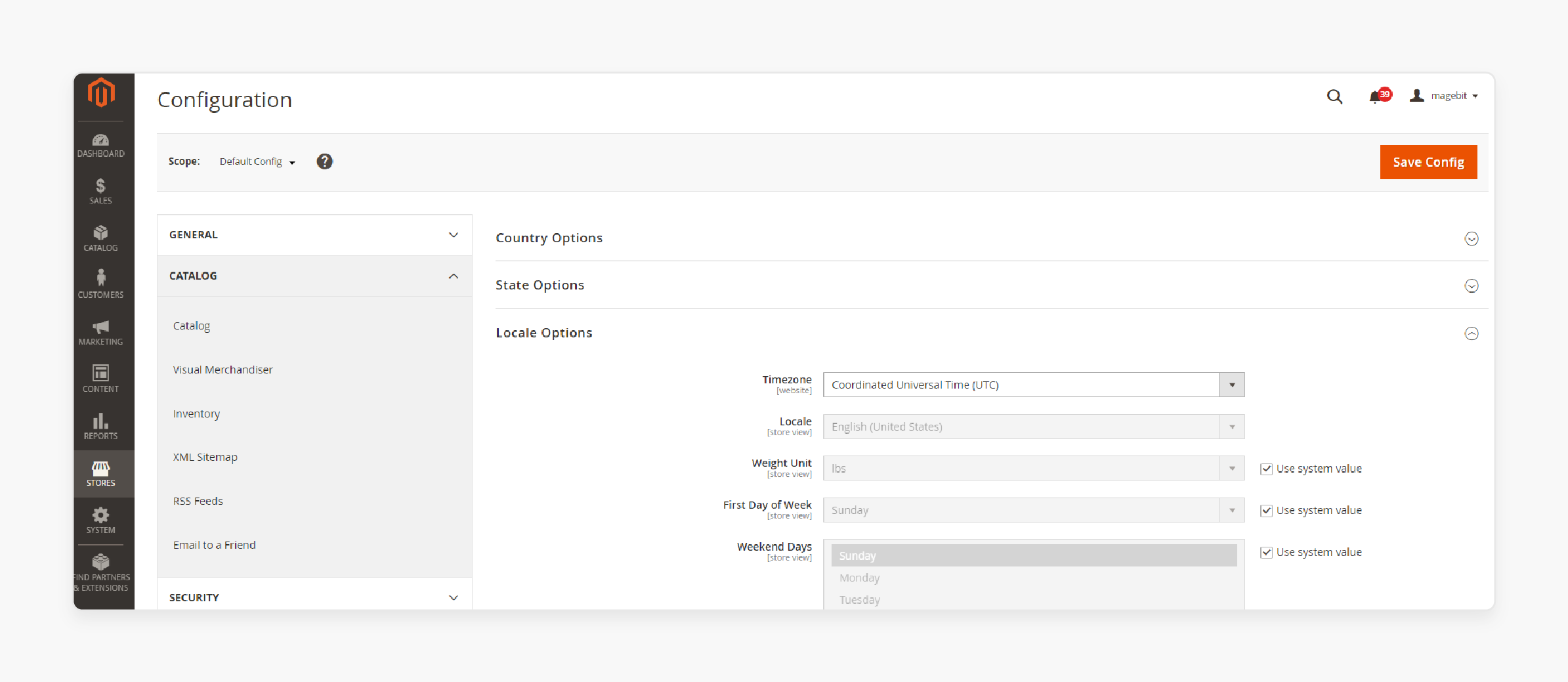
- Under the Catalog section in the left sidebar, click on Catalog.
Step 4: Choose Storefront Options
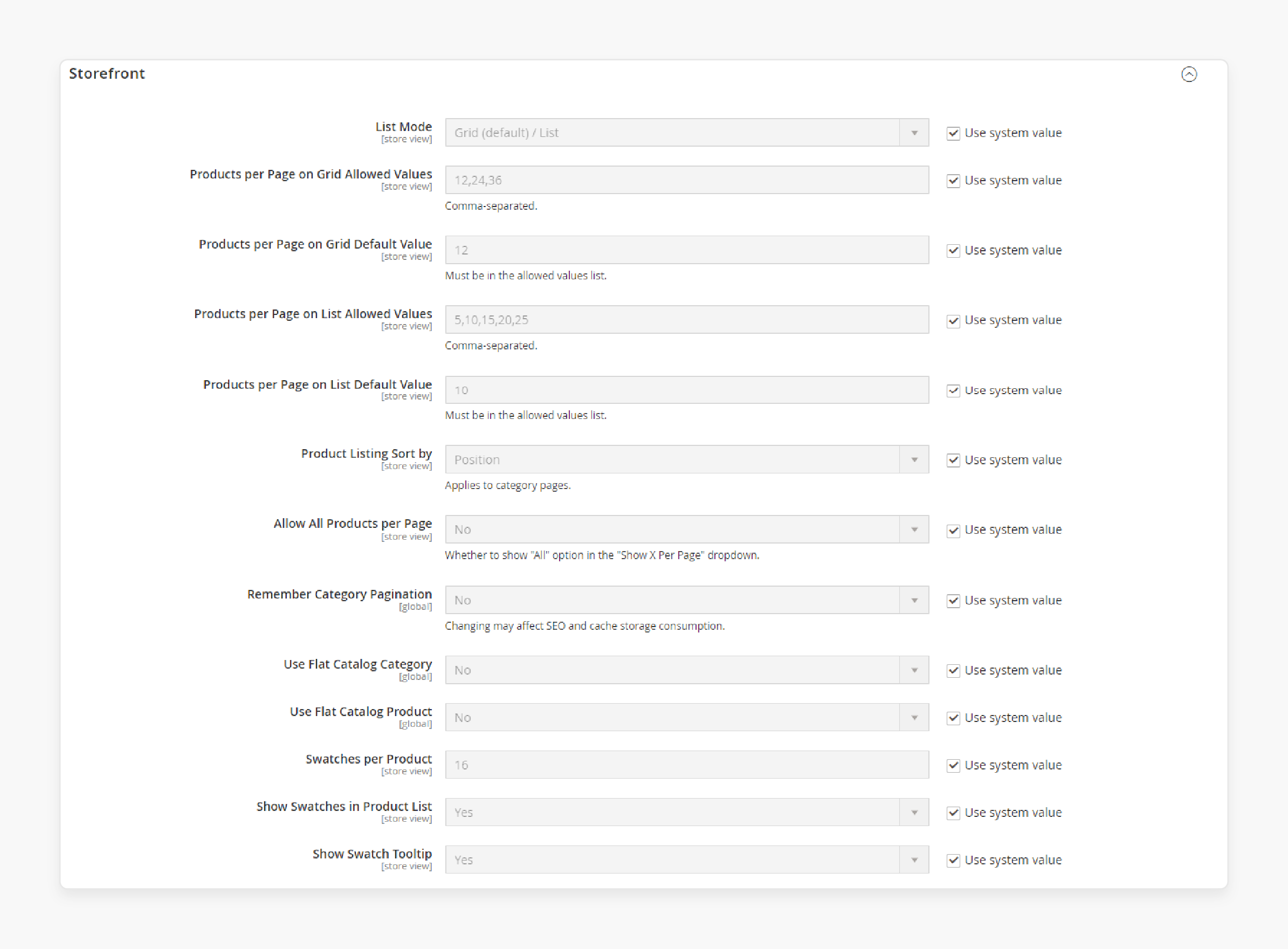
- Within the Catalog settings, select Storefront.
Step 5: Switch to List Mode

- Locate the List Mode setting and change it from Grid to List.
Step 6: Save Configuration
- Click on the Save Config button to apply the changes.
Step 7: Select Product Attributes for Display
- Decide which product attributes to include in the table view. Users may need to adjust the product listing template to accommodate these attributes.
- View each page in a more detailed manner to make informed decisions.
- Easily set the quantity of products without having to navigate elsewhere. The size of the qty box is small, which ensures it does not clutter the page.
Step 8: Clear Cache
- Go to System in the main menu, then select Cache Management.
- Clear the cache to ensure that the changes take effect.
Step 9: Testing
- Refresh the page to see the latest updates and changes to product listings.
- Go to the front of the Magento store.
- Navigate to a category page. Check that products are in a table.
- Make any necessary adjustments if the layout or appearance is incorrect.
- Once added to the cart, products are ready for checkout.
Step 10: Optimize Performance (Optional)
- Consider speeding up your Magento installation. Do this, especially if showing products in tables slows the site.
Comparison of Magento 2 Table Category View Extensions
| Extension Name | Price | Features | Compatibility |
|---|---|---|---|
| Aheadworks Layered Navigation Extension | $319 | It provides customizable grid layout options, filters, and sorting capabilities, along with a mobile-friendly design | It is compatible with Magento 2.4.x and supports both Community and Enterprise editions. |
| Amasty Improved Layered Navigation | $399 | It allows the creation of table views for category pages with customizable table designs and supports multi-store setups. | It is compatible with Magento 2.3.x and supports both Community and Enterprise editions. |
| Magedelight Magento 2 Layered Navigation Extension | $299 | It enables table view for categories, allows configuration of columns and attributes, and features a responsive design. | It is compatible with Magento 2.4.x and supports both Community and Enterprise editions. |
| Mageplaza Table Category View Extension | $99 | It offers drag-and-drop table configuration, supports pagination, and integrates with the product grid. | It is compatible with Magento 2.4.x and supports both Community and Enterprise editions. |
7 Common Issues in Implementing Table Category View in Magento 2
1. Display Problems
- Misconfigured settings might hide or misplace categories or products in a table. It could disrupt their layout or Magento styling.
- Improper coding might lead to errors in fetching or displaying the data. Leaving the display refers to exiting the current view or page.
- Fixing these issues involves changing settings, resolving conflicts, and debugging the code.
- Assign categories to specific groups to manage their display and accessibility.
- The font color for the button should be chosen carefully for better visibility and aesthetics.
2. Performance Issues
- Big catalogs can cause slow loading times for category views. It is due to slow database queries, especially if the database is not optimized for large data.
- Frontend development in Magento involves designing and implementing the user interface. Also, bad code or server issues can make the problem worse.
- Customer groups allow merchants to segment their clientele for targeted marketing strategies.
- All these issues include not having enough resources or network delays. It hinders the browsing experience for users moving through the categories.
3. Sorting and Filtering Problems
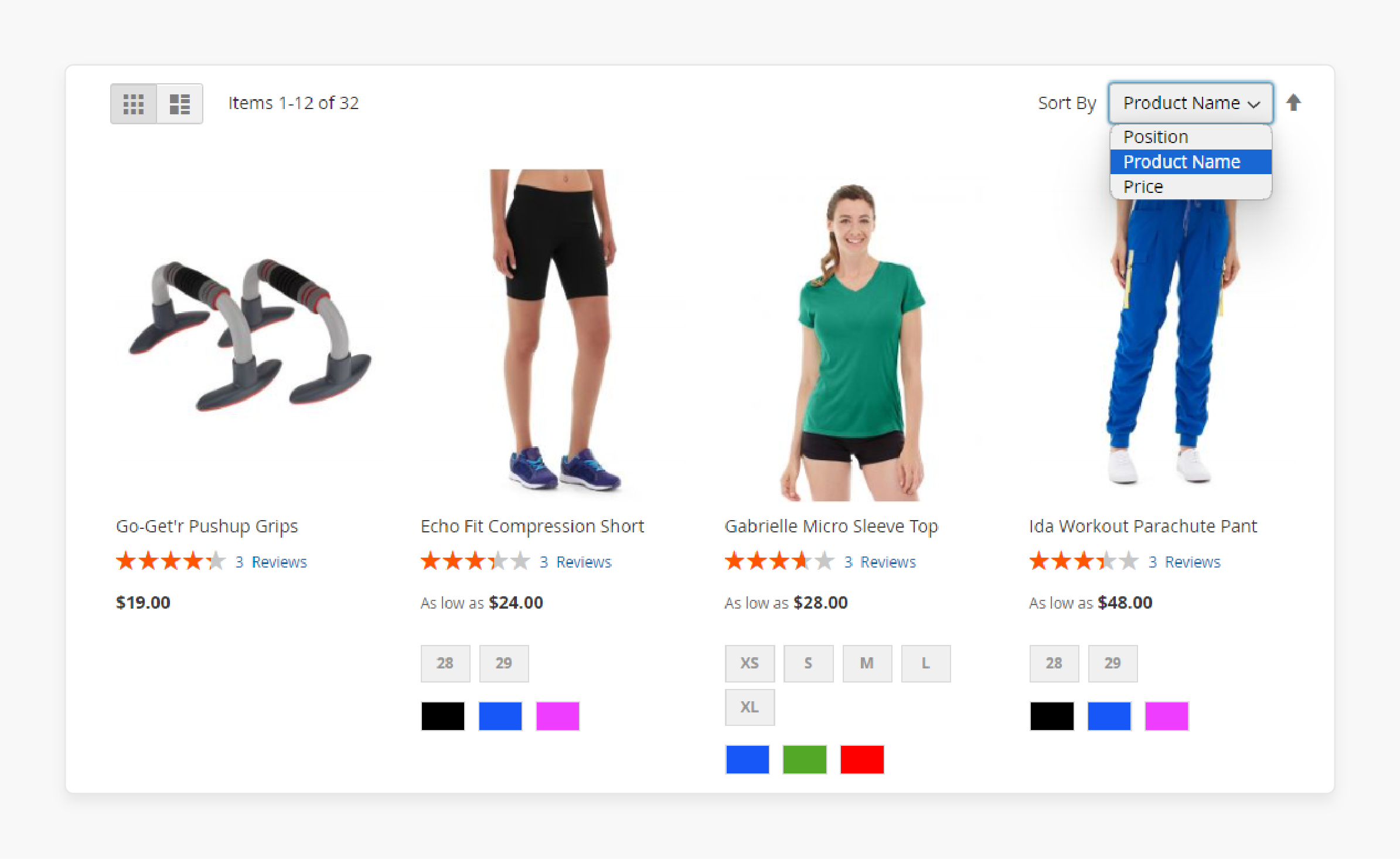
- Sorting and filtering products creates trouble. It is with products in a category or Magento using filters.
- The issues happen because of misconfigured attributes or Magento bugs. The bugs are in the sorting and filtering algorithms.
- All these issues can make listings inaccurate or inconsistent.
- It can confuse and dissatisfy users who are trying to find items or refine their search.
4. Pagination Errors
- Pagination, when done right, helps users navigate many pages of products in a category.
- It includes broken links, inconsistent product display, and slow loading times in Magento.
- All these issues make navigation hard and frustrate users.
5. SEO Concerns
- Disorganized category views can cause issues for search engine optimization. It leads to duplicate content, which harms search engine visibility.
- Problems such as missing meta tags or bad URLs make these SEO challenges worse.
- The interface is much more intuitive and user-friendly in Magento 2, enhancing the overall shopping experience.
6. Integration Problems
- Integrating a Magento store with outside systems, such as ERP or CRM software, can cause sync issues.
- SKUs (Stock Keeping Units) uniquely identify products in Magento inventory management systems.
- The problems may arise because of differences in data formats of Magento 2.
- Compatibility with configurable product grids ensures seamless integration with Magento 2's versatile product custom options.
- Magento Stack Exchange is a valuable resource for developers seeking assistance with Magento-related issues.
- It includes conflicting taxonomies and inconsistencies in data mapping between systems.
7. Cache Related Problems
- Cached data can cause inconsistencies in the category page in the table view format table.
- It requires redirection actions to the product page of each item, such as clearing or managing the Magento cache.
- The steps help ensure that users see up-to-date category information on the category page. Using good cache management is accurate and reliable.
Future Trends and Developments of Magento Table Category View
1. Enhanced Customization
In the future, more interactive features and updates are expected in real time. Merchants will have more control over the layout and look of Magento category tables. The improvements will enable merchants to improve their brand identity. It will foster a more engaging and personalized shopping experience.
2. AI-Powered Features
Users will enjoy features like product review rating, filtering, sorting, and dynamic content. It updates in real-time based on their interactions. Category views integrate AI-powered recommendation engines. Users will be empowered to explore and discover products effortlessly. AI will further enhance personalized recommendations towards products and their preferences.
FAQs
1. Why is the quantity box important in Magento 2?
The quantity box provides customers with control over how many units of a product they want to add to their cart. It enables them to easily indicate their desired quantity before proceeding to checkout.
2. Does the Grid Table View extension also support configurable products and variations?
The grid table view extension is compatible with the Magento 2 configurable product grid view extension. It supports variations. Customers can select product options from the table view and select the add to cart button. Thus, the grid table view extension in Magento 2 helps customers support configurable variants and products.
3. Can I customize the appearance and layout of the table view?
Yes, the extension allows many customization options for the table's layout. The options include product short descriptions, product images, descriptions, SKU, and other attributes. Merchants can tailor the appearance to align with their branding and design preferences.
4. Can the extension do bulk actions?
The extension facilitates bulk actions. It lets customers add many products at the same time. Also, users can add each product to the cart with a notification status at the same time. Stock status indicates the availability of a product for purchase in bulk. It also streamlined the process, greatly improving the shopping experience. The extension saves time and effort, especially for customers buying many items at once in ecommerce.
5. How can I add all items to my cart at once in Magento 2?
To add all items to your cart simultaneously in Magento 2, simply navigate to your desired category or search results page, then click on the Add All to Cart button. This feature streamlines the shopping process, saving you time and effort.
6. How does the Table-View Category page impact website performance?
The page in the table view is for categories of tables. It leads to a better user experience and more Magento engagement. Customizing it may need more resources. The gains in usability and conversion for Magento 2 stores rate are often worth any minor slowdowns.
Summary
Magento 2 Table Category View enhances product description through display and user experience. It discovers the structured layout, sortable columns, and filtering options. Here's an overview of all the steps involved-
- Log in to Admin Panel.
- Navigate to Configuration under Stores.
- Access Catalog Settings, then Storefront Options.
- Switch List Mode from Grid to List.
- Save Configuration changes.
- Select Product Attributes for Display.
- Clear Cache under System > Cache Management.
- Test the front of the Magento store.
- Check product table appearance and layout.
Ready to enhance your Magento 2 Table Category View? Explore managed Magento hosting solutions tailored to elevate your store's efficiency and foster increased interaction.




